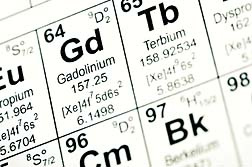 That's because an individual with kidney disease or renal failure has less capacity for the eradication of foreign content in the bloodstream than individuals with healthy kidneys.
That's because an individual with kidney disease or renal failure has less capacity for the eradication of foreign content in the bloodstream than individuals with healthy kidneys.To that end, it has been found that the use of gadolinium contrasting agents—six of which are approved for MRI by the US Food and Drug Administration (FDA)—is linked to the onset of NFS / NFD. Gadolinium, a non-radioactive contrasting agent, is injected into the bloodstream to afford MRI technicians a better image. Given the kidney's normal capacity to expel the gadolinium from the body in a timely fashion, there had been little concern for its safety.
Since that time, it has been discovered that patients with weak kidneys cannot expel the gadolinium fast enough. Thus, a pattern is emerging that patients suffering from NSF / NFD have had prior exposure to MRI gadolinium, and also happen to have weak kidneys.
The most recent example of this appeared in the Journal of Bone and Mineral Research. In "Hypercalcemia and Overexpression of CYP27B1 in a Patient With Nephrogenic Systemic Fibrosis: Clinical Vignette and Literature Review," researchers V.Y. Pao and colleagues described a 71-year-old man suffering from stable chronic lymphocytic leukemia and end-stage renal disease. The man also presented with hypercalcemia and NSF in 2006.
READ MORE MRI HEALTH RISKS LEGAL NEWS
That diagnosis came shortly after the patient had undergone an MRI scan complete with a gadolinium contrasting agent.
The researchers went on to describe that the patient presented with elevated calcium levels, and the biopsy of an NSF skin lesion showed an increased 25-hydroxyvitamin D-3-1-alpha hydroxylase (CYP27B1) immunostaining compared with the biopsy from a normal control.
"This is the first reported association of NSF with hypercalcemia caused by elevated 1,25(OH)(2)D levels, " the researchers said.
However, the link between NSF / NFD and gadolinium use associated with kidney disease, is nothing new.
